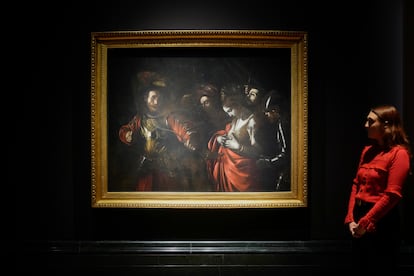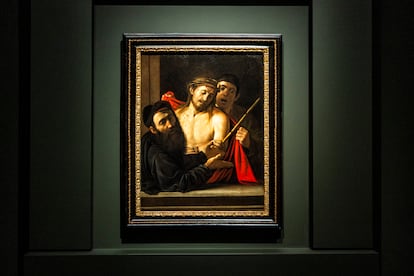In Madrid we are lucky to be able to admire the occasional canvas by the immense Caravaggio, in particular Salome with the head of the Baptistin the Royal Collections, and now Behold the Manin the Prado, a work that was considered lost. Few painters like him will have sought to kill death. The violence of his works has grown over the years. When we come across The vocation of Saint Matthew o The martyrdom of Saint Matthewthere it is, as if it were a beast taking bites, taking out its claws, so that death retreats. There they are dancing life and death, the light and the dark, fighting, hugging each other with passion.
On his canvases he makes the bodies of ruffians and low-life women appear. Suddenly, it turns them into saints, virgins, along with Christ, or the apostles. It opens a luminous gap that plunders us from the inside, leaving us stunned. Suddenly, the truth and the sacred become incarnate, they put flesh on top. The visible is crushed with an ax blow, the kingdom makes its way. When the works were finished, the Romans rushed in, queuing to see them in the chapel of San Luis de los Franceses. Great works of art are not only seen with the eyes, but also with the spirit. Caravaggio was a fast painter, he didn’t even make drawings before jumping onto the canvas.
However, it took him more than a year to finish those works, to find that light, those blacks, to give depth to the shadows, to show that face to face with crime or with Christ. The face that contorts, the naked body that shines, that shows its wax, everything here was overwhelming. Because what the artist is doing is unprecedented. He is killing death, fully entering eternity. What it portrays is something impossible, a dark act, a crime. Mercy opposes this invasion of evil. On one side, the murderer of Mateo, on the other, in front, the Christ, who saves everything. We are now in 1601, everywhere Caravaggio triumphs.
Contracts multiply like bread. The cardinals give him orders, and he then locks himself in a dark workshop, almost a cave, a basement, where the black light works like an alchemist. There he begins to look death in the eyes and from that face to face those canvases are born that now dazzle us. Caravaggio is then a king who shakes off his lice in the taverns and throws his crown in the seedy alleys, squanders everything, because the only thing that matters to him is in that basement, in that fight in which he does not even seek to win. nor come out unscathed. He simply throws out his hand, and, without a blur, he blurts out the colors, the light ones, the dark ones, to the big girl who makes the scythe play with her wrist.

Most humans spend their time running away from that confrontation. He doesn’t even hesitate, he holsters, unholsters, takes out the brush, takes out the blade. In the paintings the real becomes flesh. Bodies weigh, hands speak. Even when the heads have been cut off, when the eyes have stopped seeing, looking, the feet, the hands, the bodies remain, which fall. Here there are no angels that fly, virgins that levitate, and halos everywhere. Reality is dirty, hence the feet are unwashed, hence the hands are twisted, the fingers are like screws, nails, they know that the cross will come, that something terrible will come. Hands grab volumes of air, torsos weigh. We know, we will not emerge from this life unscathed.
The irony of fate will be terrifying with the Caravaggio. From fame he goes to nothing. For several centuries there was no mention of him. Erased. Forgotten. Until, in the middle of the last century, an art critic, Roberto Longhi, organized an exhibition in Milan in 1951 and unearthed it. Therefore, death is not eternal. Caravaggio is reborn, but this time for good. We have forgotten all the painters with whom he fought, sword in hand. Now his works are everywhere, in Rome, in Florence, in Malta, one of his Christs in the Vatican, another in Potsdam, another in London, another in Dublin, and, of course, some of his works also in Madrid.
We travel for entire summers, there we go in herds, in streams, watering the streets, sunbathing on the beaches. Maybe we should go the other way. Travel inwards. Get in front of a caravaggio and watch how life and death, how the light and the dark, snatch eternity from death.

